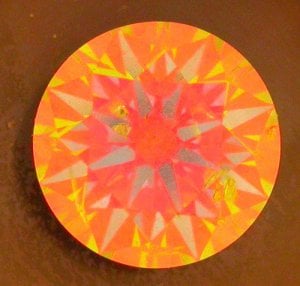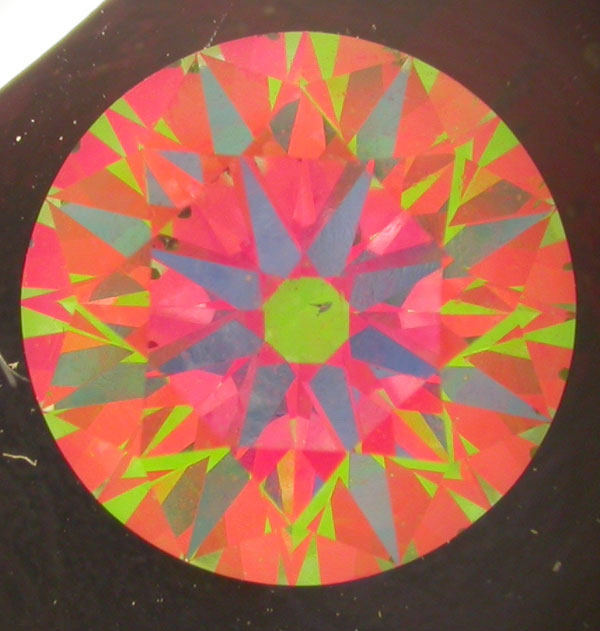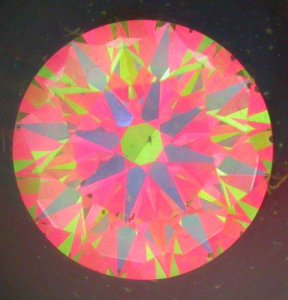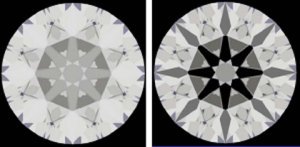- Joined
- May 3, 2001
- Messages
- 7,516
oh...i cannot take credit for the model, it is one sir john posted as a reference. i just happened to notice the striking similarities between the two and wanted to show them side by side.Date: 6/6/2005 4:13:59 PM
Author: denverappraiser
I need to do some homework in analyzing these things. There''s quite a bit of data inculcated in that and I''m not sure what to make of it. Belle, how did you produce the model? That looks like DiamCalc but ASET isn''t one of the options in mine.
Neil Beaty
GG(GIA) ISA NAJA
Independent Appraisals in Denver

Neil, I took the one at the booth through the eyepiece of the desktop model, with weird exhibit hall lighting. Jim Caudill has designs on standardizing the lighting environment for photographic and casual viewing purposes in the near future.Date: 6/6/2005 6:07:45 PM
Author: denverappraiser
All in all this looks VERY different from the photo that John took at the booth.


Michael,
This is definitely an artificial viewing environment but that doesn’t mean that it isn’t useful. X-ray’s are artificial as well but doctors seem to find them helpful in the right circumstances. I certainly agree that it’s important to be careful about starting with a very narrow observation like this and generalizing from that but there is clearly some interesting data inculcated in these images and there is some possibility that that data will be useful in analyzing diamonds. Wink’s observation about the green table being a clue to the pavilion angle is a wonderful case in point. This is something that is decidedly difficult to measure directly (especially on mounted stones), is of definite interest and is not easily observable with any other tool that I’m aware of.
I certainly agree that it would be a mistake to conclude that green=bad or to make similar blanket statements based on these images. I’ll even agree that leaping to this sort of conclusion is the general tendency of many people. It’s not magic, it’s just another piece of the puzzle. Surely you agree that it’s a pretty interesting piece.

The other thing that seems obvious to me, please straighten me out if I am wrong here, is the same problem that is inherent with the Idealscope and that is by being as close to the stone as you are when viewing it, and using magnification, you are getting a picture of the stones reflective patterns that are not the same as what you would get if the stone were at arms length. Leakage for instance, does not occur at just one angle at the points that show leakage. It occurs at various angles around that area forming a 'cone' of leakage that has some narrow included angle and neither the Idealscope or this ASET scope can give you any idea of the included angle of the light leakage or reflections that are what you will ACTUALLY be seeing when you are holding the stone at arms length. If the included angle of the light leakage 'cone' is a very small angle and the angle away from perpendicular to the table that those leakage areas are directed is over a couple of degrees, then you will never see the 'leakage' usless you tilt the stone and then you will only see one very small spot at a time. I'm afraid that both of these devices, since they capture an image so close to the stone, really don't give you as much of an ability to analyze the stone as you may be thinking they do.

On a more postive note, if you wanted to have the same imaging capabilities with the hand held version it would be an easy rework to place a clear plastic or glass plate across the end of the instrument and then hold the stone against it with a small black foam filled cone. This would allow you to hold the table flat against the clear plate and block any back lighting. Same thing would work with the Idealscope.
Good idea. It would save one some $. Desktop model for non-members is a grand. The problem is that the hand held version has such a tiny viewing aperture. I am tempted to ask Neil how in ‘tarnation’ (Texas word – yee-haw) he got those shots.
Glare and angle of incidence are clearly important. I also asked Jim about it but I didn''t get to actually look at the piece of glass. He was quite busy when I visited and I''m just some podunk appraiser from Colorado. I think you got a better interview than I did.Date: 6/7/2005 8:13:11 PM
Author: JohnQuixote
By the way Neil, with regard to glare, I remembered prior conversations we have had and asked Jim about that. First, the desktop ASET has dual anti-glare treatment on the bottom side 2mm thick and single treatment on the top. He also talked a whole bunch about angle of incidence and the work they have done with the cone to avoid glare/reflection/bad hair day/etc, but I had eaten a big burrito for lunch and the details are fuzzy in my memory.
Though it''s nice that we''re enthusiastically attacking interpretation, I think further study - especially with regard to standardizing lighting environment - is going to be necessary before we can give detailed assesment.Date: 6/7/2005 6:00:55 PM
Author: Wink
Amazing how much more this picture tells you. The ideal scope shows a nice stone that is obvously tilted a little for its photo. This photo also appears to be a little tilted, but that will be corrected with the desk top model that allows us to lay the stone on its table so that any apparent tilt will indeed be in the stone not the holder.

Here is what I see in the above stone. It has lots of red and perhaps a little more green that we would like. I am betting that this stone will NOT get an AGS 0 cut grade but probably a one or a two, you can tell me how far off I am if this stone has one of the new AGS papers. Since the table reflection in the center of the stone is green we know that the pavilion angle is less than 40.768 degrees. (If it were 40.768 degrees or greater the table reflection would be red, interesting, yes?)
Also, since the stone has a great amount of red with some good blue in the red for contrast this stone should show a great deal of dynamic brilliance that POPS as the stone moves even small degrees. This stone should SIZZLE!
The black shows us only minimal amounts of leakage, this is a good looking stone!
Wink
P.S. Niel, you have the stone in hand, how close am I?
Date: 6/7/2005 8:33:25 PM
Author: denverappraiser
What do you think of the green table? any other interesting observations?

Jimminy Cricket, Neil !Date: 6/7/2005 8:33:25 PM
Author: denverappraiser
To take the final picture, I cut the bottom off of a standard Kodak type film can and taped it to the ASET with electrical tape. This allowed me to set my camera on the desk facing straight up and balance the ASET directly on the lens. I put a sheet of glass on top of that and put a pen cap from a Sharpie over the top of the stone to block out the transmitted light. I suspect that replacing the glass with the correct material would result in a pretty good replication of the tabletop unit for photographic purposes and for a bunch less money unless you use a special Gemological sharpie (available only from Gem-A).

Date: 6/7/2005 8:55:01 PM
Author: JohnQuixote
Date: 6/7/2005 8:33:25 PM
Author: denverappraiser
What do you think of the green table? any other interesting observations?
The green in the center is as Wink noted: The 40.7 PA makes sense, because less than 40.768results in that fascinating green dot (come-on guys - thousandths? please shoot me now!). Wink, that was on a chart for 57% table. Do you recall if 56% table (and others) result in this too?
Date: 6/7/2005 8:58:09 PM
Author: JohnQuixote
Date: 6/7/2005 8:33:25 PM
Author: denverappraiser
To take the final picture, I cut the bottom off of a standard Kodak type film can and taped it to the ASET with electrical tape. This allowed me to set my camera on the desk facing straight up and balance the ASET directly on the lens. I put a sheet of glass on top of that and put a pen cap from a Sharpie over the top of the stone to block out the transmitted light. I suspect that replacing the glass with the correct material would result in a pretty good replication of the tabletop unit for photographic purposes and for a bunch less money unless you use a special Gemological sharpie (available only from Gem-A).
Jimminy Cricket, Neil !
You said you wanted a new avatar while we were in Vegas.
I suggest you choose one of these:
No, it is an informational issue. 40.5 is lower than what Paul usually cuts I believe, but within the parameters of the AGS ideal if I remember correctly. Pauls stones are still receiving the coveted AGS 0 cut grade. I do not think that the green/red table reflection will be anything other than an interesting bit of information that can be instantly perceived from looking at the image. I just thought it a fascinating bit of trivia that was presented to us at the AGS lecture at their laboratory and was sharing it with you. Later I will try to show you part of the charts that were given to us at AGS, it will be much more relevant when seen with other images than when taken out of context.Date: 6/8/2005 9:37:27 AM
Author: strmrdr
Is the red vs green center a quality/performance issue or a personality issue?
How is it considered when assigning the cut grade?
Paul often cuts his diamonds with a 40.5 pavilion angle are they going to be downgraded under the AGS system?
Green is not bad, depending on the size and distribution of those areas in an image. It is one of the two vehicles whereby brightness contrast effects are produced (the other is leakage). A diamond like this one is drawing a majority of light from high angles, so the green over the culet should enhance contrast in a positive way.Date: 6/8/2005 9:37:27 AM
Author: strmrdr
Is the red vs green center a quality/performance issue or a personality issue?
How is it considered when assigning the cut grade?
Paul often cuts his diamonds with a 40.5 pavilion angle are they going to be downgraded under the AGS system?
AGS reports that this stone would get a AGS-0 grade under their new performance grading system as well.Date: 6/8/2005 8:30:06 AM
Author: Wink
Neil, you should be able to call AGS and find out what the new paper would be on that stone since it was graded less than six months ago and I believe after the time when they started keeping data on both grading scales.

